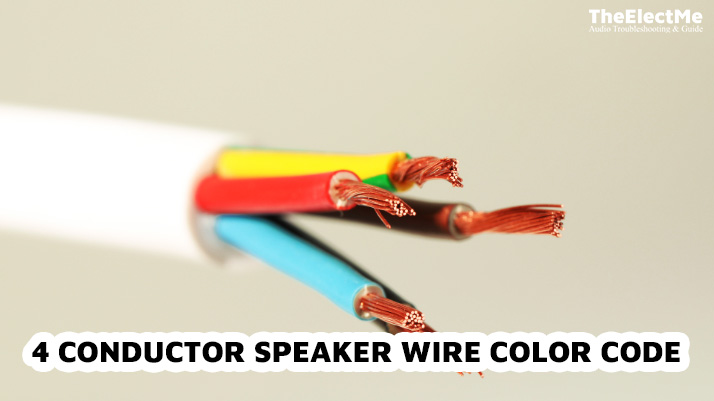Four primary colours make up the color code for 4 conductor speaker wire – red, black, white, and green. But what do these colours mean, and why is it important to understand them in your audio setup? To answer these questions, read the ultimate guide to 4 conductor speaker wire color code.

What Are The Color Codes In 4 Conductor Speaker Wires, And Why Do They Matter?
Four primary colours comprise the color code for the 4 conductor speaker wires. Here is the breakdown of their meanings and functions:
1. Red
This color represents the positive terminal of the speaker wire. It is also known as the hot or live wire. It carries the audio signal from the amplifier to the speaker.
2. Black
The black wire indicates the negative terminal of the speaker wire. Black wire, also known as ground, this wire completes the circuit for proper sound reproduction.
3. White
The white colour is used for positive polarity identification in specific colour code schemes. It is also referred to as cold or neutral wire.
4. Green
This colour represents the negative polarity in some colour code schemes. Similar to the white wire, it is known as cold or neutral.
These wires are made of either copper or aluminium. These materials are good conductors of electricity and allow for the smooth flow of audio signals. Copper is preferred due to its higher conductivity and lower resistance.
Why are there different colours in the 4 Conductor speaker wire color code?
Here are the purposes of these colours in 4 conductor speaker wire color code:

1. Identification
Each wire colour has a specific function, making identifying and connecting the speakers easier. This prevents any confusion or mistakes while setting up an audio system.
2. Polarity
The red and black wires represent positive and negative polarity, respectively. Ensuring correct polarity is essential for balanced sound reproduction. It also prevents sound distortion and damage to the speakers or amplifiers.
3. Standardization
Following industry guidelines and adhering to colour code standards allows for consistency in audio setups. This makes it easier for consumers to understand and connect their speaker wires, regardless of the brand.
4. Safety
Having a designated colour code for speaker wires also ensures safety. Mixing up wires or misconnecting them can lead to electrical hazards and damage to equipment. With a standard colour code, it is easier to identify and troubleshoot any issues.
5. Aesthetic Appeal
In addition to functionality, colour coding adds visual appeal to audio setups. It allows for neat and organised cable management. The result is a clean and professional-looking setup.
Step-by-Step Guide: Proper Connection Techniques of 4 Conductor Speaker Wire
To ensure the best audio performance, it is crucial to understand how to connect your 4 conductor speaker wire correctly. Here are some tips for proper connection techniques of 4 conductor speaker wire color code:

1. Identify the Positive and Negative Conductors
The first step is to identify the positive and negative conductors in the wire. This will vary depending on which colour coding scheme you are following. For example, some methods use a solid colour for positive and a striped or dashed pattern for negative.
The red and black cables in 4 conductor speaker wires indicate positive and negative polarity, respectively.
2. Prepare the Wires
After identifying the conductors, the next step is to prepare the wires for connection. Strip off about 1/2 inch of insulation from each wire end using a wire stripper or sharp knife. Make sure not to damage the actual wire while stripping.
3. Connect the Wires to the Terminals
It’s time to connect the wire ends to their corresponding terminals. Make sure to match the colours correctly – red with red, black with black, etc. The positive terminal is usually marked with a “+” sign, while the negative terminal may have a “-” character or be color-coded.
4. Ensure Secure Connections
When connecting the wires, ensure they are tightly secured to the terminals. Loose links can lead to sound issues or even damage to equipment. Use a screwdriver to tighten any loose connections.
5. Test Your Setup
After completing the connections, you must test your design by playing audio. Make sure no abnormal sounds or distortions are coming from the speakers. If there are any issues, double-check your connections and wires.
Troubleshooting Tips and Best Practices for 4 Conductor Speaker Wire Connections
Even with proper connections, there may be times when you experience issues with your 4 conductor speaker wire. Here are some common problems that can occur and how to troubleshoot them:

Loose Connections and Intermittent Sound
If you notice a buzzing or intermittent sound from your speakers, it could be due to loose connections. Check all the wire connections and make sure they are securely fastened.
Sound Imbalance and Phase Issues
Sometimes, the sound from one speaker may be noticeably louder than the other. This could be due to incorrect wiring or a phase issue. Ensure that both positive and negative terminals are connected correctly, and check the phase settings on your amplifier.
Grounding and Noise Reduction Strategies
Another common problem is unwanted background noise or interference. This can be caused by poor grounding or nearby electrical devices. Make sure to ground all audio equipment and use noise reduction techniques properly. It involves shielding the wires or using a ground loop isolator.
Frequently Asked Questions
Why does my speaker wire have 4 wires?
The 4-wire speaker is used to run stereo pairs in home audio setups. Two wire handle one channel while the other two hold the second channel.
Can you use a 4 conductor speaker wire for 2 speakers?
A 4 conductor speaker wire is designed for two speakers or a stereo pair. It can connect 2 speakers to one amplifier, simplifying the setup process.
Can you run 4 speakers on one channel?
An unlimited number of speakers can be added to a channel when connected in series or parallel. Follow the manufacturer’s maximum speaker load per channel guidelines to prevent amplifier damage.
Conclusion – 4 Conductor Speaker Wire Color Code
To summarise, the 4 conductor speaker wire color code consists of black, red, white and green. These four colours make it possible to connect without confusion. It ensures proper polarity, safety, and aesthetics in your setup. Despite challenges in standardisation, it’s crucial to follow industry guidelines and use proper colour coding for optimal performance.
With this knowledge, you can confidently connect and troubleshoot your 4 conductor speaker wire setup. So, master the art of speaker wire color coding to elevate your audio experience.



